| Conservation of the Franciscan Section |

|
|
During September-November 2010 conservation measures were implemented in the Franciscan section of the city wall. The conservation action, undertaken on behalf of the Israel Antiquities Authority and underwritten by the Jerusalem Development Authority, was directed by Eran Hemo, with assistance from Yoram Sa'ad, Avi Mashiah and Yuval Avraham (planning), Ofer Cohen and Yael Rosenthal (engineering), Jacques Neguer and Mark Avrahami (artistic conservation) and Avi Peretz (conservator in charge). The conservation measures conducted in the field were implemented by Khalid Abu Sanina, Mohammed Abu Ramilla, Wahal Basti, Ahmed Da'is, Mufid Samara and Badar Shaldi.
|
The Franciscan section is the westernmost section in the city's northern wall. To the east of it is the Damascus Gate section and to the southwest is the Zahal Square section. On the inside of the wall is the Christian Quarter, with its public buildings, and on the outside is the main road and the light rapid transit rail line.
Physical Data
The overall length of the Franciscan section is c. 233 m. Today, the inner facade rises to a height of 7.70-9.60 m above the surface level and the outer facade is 9.00-11.20 m above the surface. The wall's outer facade extends across an area of 1,702 sqm while that of the inner facade is 440 sqm. The New Gate was constructed at the western end of the city wall and stands 5.20 m high by 3.60 m wide.
Conservation Values:
Historical Values. Breaching the city wall and the construction of the New Gate were done as part of the exodus from within the Old City walls and the need to unite it to the New City. The gate was intended to connect the public and residential buildings in the Christian Quarter with those situated outside the city walls. During the period when the Jordanians occupied the Old City the northern wall served as the borderline between Israel and Jordan. This was manifested by blocking the spaces between the crenellations and positioning guard posts at strategic points, one of them being at the New Gate. The battles have left their mark on the gate as evidenced by its lintels which bear the bullet damage that has since become obscured over time.
Urban Values. The Franciscan section is located in the western part of the northern city wall, and serves as the border between the Christian Quarter inside the city and the Christian buildings north of the city walls. The New Gate in this wall creates a vital link between the Christian owned buildings on both sides of the city wall. This section of the city wall is situated alongside the light rapid transit rail line and is therefore exposed to extensive pedestrian traffic.
Architectural Values. The New Gate was breached in the late nineteenth century and this is evident in its architectural style and physical characteristics. The gate's lintel, composed of alternating protruding and inset stones, is typical of the construction of openings in the nineteenth century. In addition, unlike the Ottoman gates, the New Gate was built to be wide enough to allow for vehicular traffic and pedestrians at the same time, and no space was constructed alongside it that was used for defensive purposes.
Physical Problems:
The Franciscan section of the city wall was relatively well-preserved; the skyline is full and is unobstructed for the most part. There is bullet damage in the New Gate and a lintel stone is missing on the inside.
Conservation Issues:
The Franciscan section is mainly characterized by later changes that were made to the walls, beginning with the breaching of the New Gate in the second half of the nineteenth century, and other modifications that were made during the British Mandate and the Jordanian occupation of the city. The conservation work compelled us to address an important issue of whether to preserve the later interventions or to give precedence to the original architectural values of the Ottoman city wall. In this section it was decided to conserve the later changes that were made to the wall, in contrast with other sections in which the later Jordanian interventions were removed or British changes were fixed in accordance with new information.
The contour of the breach in the New Gate was emphasized. This distinguishes it from the other city portals, as a gate that was opened in the Ottoman wall in a later period and is not an original part of it. In addition, it was decided to conserve the Jordanian additions in the section, which included concrete walls that formed a guard post in the New Gate, and stone blockages between the crenellations. In this manner the Jordanian period is expressed in this section of the city wall. Massive conservation and rehabilitation work was done to the line of crenellations at the time of the British Mandate. In this instance it was decided not to touch the crenellations because the historical information we possessed was insufficient.
Conservation Measures:
1. Completing the lintel stone in the New Gate (Figs. 3,4).
2. Conserving the bullet damage. The gate's lintel and the adjacent facades were pockmarked by rifle bullets during the wars. The damage caused by the bullets was preserved (Figs. 5,6).
3. Cleaning the gate. The gate's inner facades were rinsed clean of patina and glue (Figs. 3,4).
4. Stabilizing the crenellations. The constructive state of many of the crenellations along the section of the Franciscan wall was poor due to vegetation having taken root, stone disintegration and cracking. The crenellations were treated by dismantling them, removing the vegetation, stabilizing the stones, rebuilding them and pointing up their joints (Figs. 7,8).
5. Removing the vegetation. Due to the penetration of water, vegetation took root at the top of the lower sentry post and along the course in which the railing was secured on the upper sentry post. The treatment included pointing up the stone joints and pouring new lime-based coping (Figs. 9,10).
6. Base of the wall. There were regions at the base of the city wall where the absence of mortar was evident and vegetation had taken root. The treatment included removing the detrimental seasonal vegetation and filling in the joints with mortar and stone wedges (Figs. 11,12).
|
|
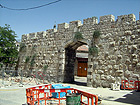
|
1. The facade of the New Gate prior to conservation, 2011.
All Photographs by Yuval Avraham. |
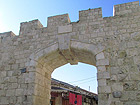
|
| 2. The facade of the New Gate after conservation, 2011. |
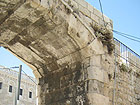
|
| 3. Patina stains on the inner facade of the gate, 2011. |
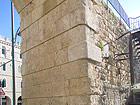
|
| 4. The inner facade after cleaning, 2012. |

|
| 5. Bullet damage to the gate's lintel prior to intervention, 2011. |

|
| 6. The gate's lintel after conservation, 2012. |
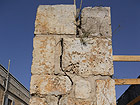
|
| 7. Cracking and vegetation that took root in the crenellations prior to conservation, 2011. |
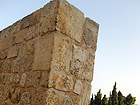
|
| 8. The crenellations after dismantling, removal of the vegetation and rebuilding, 2012. |
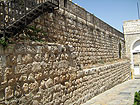
|
| 9. Vegetation that had taken root in the lower sentry post, 2011. |
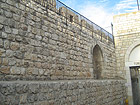
|
| 10. The lower sentry post after the vegetation was removed, 2012. |
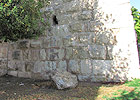
|
| 11. Mortar missing from the base of the city wall, 2011. |
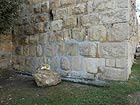
|
| 12. The base of the city wall after filling it with mortar, 2012. |
|















